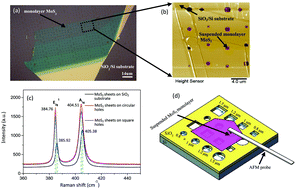Hysteresis and its impact on characterization of mechanical properties of suspended monolayer molybdenum-disulfide sheets†
Abstract
The hysteresis phenomenon frequently arises in two-dimensional (2D) material nanoindentation, which is generally expected to be excluded from characterizing the elastic properties due to the imperfect elastic behaviour. However, the underlying mechanism of hysteresis and its effect on the characterization of the mechanical properties of 2D materials remain unclear. Cyclic loadings are exerted on the suspended monolayer molybdenum-disulfide (MoS2) films in atomic force microscopy (AFM) nanoindentation experiments. The elastic hysteresis loops are observed for most of the force–displacement curves. The friction/wear between the AFM silicon tip and the MoS2 monolayer is deemed to be dominant compared to the friction between the monolayer and the silicon dioxide substrate after the analysis, as determined using the finite element method (FEM) simulation. The loading force–displacement curves instead of the unloading curves have been used to deduce the elastic mechanical properties using a modified regression equation. The mean value of the obtained Young's modulus of monolayer MoS2, E, is equal to 209 ± 18 GPa, which is close to the inherent stiffness value, predicted by first principles calculation. Our results have confirmed that it is not obligatory to exclude the sample data with hysteresis behaviour for characterizing the elastic properties of 2D materials. In addition, all sample sheets have finally been penetrated and the mean breaking stress value, σmax, is 36.6 ± 0.9 GPa, determined using the radius value of the worn tip. Furthermore, the effect of the loading force and the shape/size of the suspended monolayer MoS2 sheets on the hysteresis behaviour in the 2D nanoindentation have also been analyzed and discussed, exhibiting interesting trends. Our findings provide guidance for the characterization of the mechanical properties of 2D materials using the AFM nanoindentation and the experimental samples with elastic hysteresis behaviour.



 Please wait while we load your content...
Please wait while we load your content...